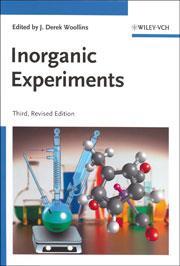Inorganic experiments
Inorganic experiments
J Derek Woollins
Weinheim, Germany: Wiley-VCH 2010 | 456pp | ?50.00 (HB)
ISBN 9783527324729
Reviewed by Dominic Wright

A unique feature of the first and second editions of Inorganic experiments (edited by Derek Woollins) which marked them out from other books on practical inorganic experiments, was the contribution of well-tested experiments from a broad section of world-leading experts in inorganic chemistry.
This approach is continued in the latest (third) edition of this text, with the addition of around 18 new experiments which brings the total number to 96 in all. The sheer breadth of experience and genuine expertise which this book draws from would be impossible to rival using a smaller author base.
A further feature of this multi-author approach is that it brings with it a perspective of what is current and new in inorganic chemistry, and many of the more advanced experiments concern aspects of inorganic chemistry that have only relatively recently been published. Careful consideration of the content of this book has led to a well-balanced cross-section of experiments which cover all of the important and developing fields of main group, transition metal and coordination chemistry.
Essentially the same organisational style is retained in the latest edition, in which experiments are neatly divided into introductory, intermediate and advanced sections as a rough guide to difficulty.
As a result of the scope and range of the experiments involved, there is inherent flexibility in devising a practical course based on this book.
The addition of a short chapter on spectroscopic sample preparation and reporting of experimental data is extremely useful and addresses a key area that was lacking in the first two editions.
Specific aspects of safety and background reading are included separately for each experiment.
The experiments described in the text stretch from standard introductory practicals (such as the preparation of CuI) to the exotic (sulfur-nitrogen chemistry and highly reactive transition metal organometallics) and concern the full breadth of inorganic techniques currently employed, such as basic synthesis, separation and purification, inert-atmosphere techniques, NMR and EPR spectroscopy and magnetic measurements.
Like the first and second editions of Inorganic experiments, the third edition is clearly and concisely written and excellently produced. In my view the flexible, expertly informed approach that this book offers make it essential reading for academic and technical staff who are planning a modern inorganic course.












No comments yet